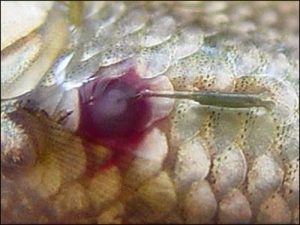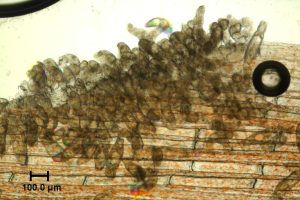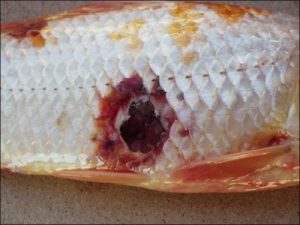Knowing the signs and symptoms of illnesses is important to keeping your Blue Ridge Koi healthy.
Anchor Worm
 Cause: New fish or aquatic plants can introduce these crustacean parasites into your pond.
Cause: New fish or aquatic plants can introduce these crustacean parasites into your pond.
Symptoms: Anchor worms are visible and resemble whitish-green threads. You may notice red patches on the koi where the skin around the parasite has become inflamed.
Treatment: Remove each worm using tweezers or small pincers and treat the area with a topical antibiotic. Eliminate eggs and free-swimming larvae with a veterinary-approved product, such as diflubenzuron (dimilin) or potassium permanganate–either as a dip in a quarantine tank or the entire pond (5-10ppm).
Costia
 Cause: Costia is a microscopic parasite that is recognizable by its pear shape and two pairs of flagella (appendages that help it swim and latch onto hosts.). Outbreaks are more likely to occur in early summer.
Cause: Costia is a microscopic parasite that is recognizable by its pear shape and two pairs of flagella (appendages that help it swim and latch onto hosts.). Outbreaks are more likely to occur in early summer.
Symptoms: Koi infected with costia might rub themselves against surfaces to alleviate discomfort. You might notice labored breathing or grayish-blue epidermal mucus. Fish can become lethargic, stop eating, and clamp their fins.
Treatment: One option is to add salt at a salinity of 6 ppt or 0.6% for 72 hours. Potassium permanganate can also be used. Take care when dosing and administering potassium permanganate, as it can be lethal to fish. Another option is an over-the-counter broad-spectrum disease treatment, such as Proform-C, that contains formalin and malachite green. Follow manufacturer directions when dosing. Do not use salt and products containing formalin together, this can be lethal to fish.
Ich

Symptoms: Ich produces white spots on the body and fins. It also can cause clamped fins and cloudy eyes. Koi might become lethargic, gasp at the pond’s surface, or use rocks to scratch themselves.
Treatment: Increase the pond’s salinity to 3.5 ppt or 0.35% for up to 21 days to eradicate the parasite throughout. Clean the pond’s rocks and gravel, as these parasites tend to replicate at the bottom.
Fish Lice

Symptoms: Though these parasites are visible, you might initially notice your fish attempting to scratch against rocks or other pond structures. Redness and irritation can occur around the attachment site as well.
Treatment: After carefully removing the lice, apply topical antibiotic ointment on the lesions. Try to take care of the problem quickly, as fish lice can lead to a variety of bacterial infections. You will need to treat the pond water to avoid further spread. Potential chemical treatments include dimlin and potassium permanganate. In severe cases, a complete water change might be necessary.
Flukes

Symptoms: Both gill and skin flukes are too small to see without a microscope. You may notice your koi gasping at the water’s surface or exhibiting flashing or jumping behaviors.
Treatment: Use treatments such as potassium permanganate or praziquantel. Because these medications will not impact fluke eggs that are unhatched, several rounds of treatment may be necessary to resolve the infestation.
Bacterial Infection

Symptoms: Afflicted fish may experience discoloration or frayed or missing fins. Ulcers can develop, causing red, raised patches or small, circular, bluish-white spots. Your koi may exhibit flashing and lethargy.
Treatment: Antibiotics can be effective only if the underlying cause or causes are remedied.
Download PDF

Comments are closed.